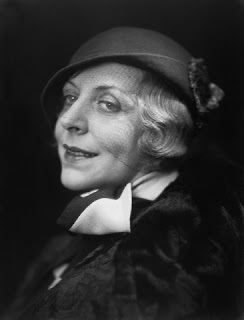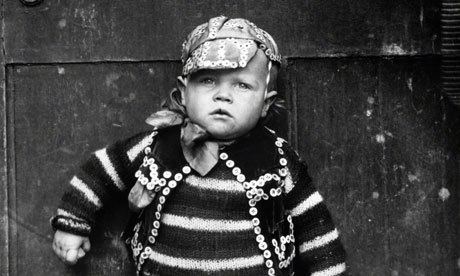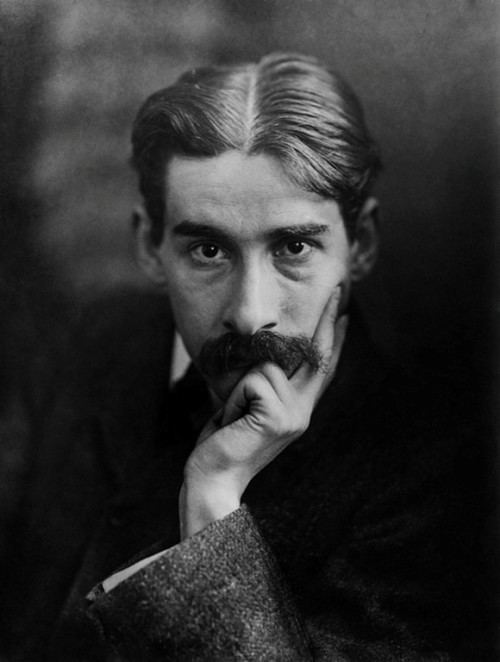Emil Otto Hoppe (14 April 1878 – 9 December 1972) was a German-born British portrait, travel, and topographic photographer active between 1907 and 1945. Born to a wealthy family in Munich, he moved to London in 1900 to train as a financier, but took up photography and rapidly achieved great success.
He was the only son of a prominent banker, and was educated in the finest schools of Munich, Paris and Vienna. Upon leaving school he served apprenticeships in German banks for ten years, before accepting a position with the Shanghai Banking Corporation. He never arrived in China. The first leg of his journey took him to England where he met an old school friend. Hoppe married his old school friend's sister, Marion Bliersbach, and stayed in London. While working for the Deutsche Bank, he became increasingly enamored with photography, and, in 1907, jettisoned his commercial career and opened a portrait studio. Within a few years, E.O. Hoppe was the undisputed leader of pictorial portraiture in Europe. To say that someone has a "household name" has become a cliche, yet in Hoppe's case the phrase is apt. Rarely in the history of the medium has a photographer been so famous in his own lifetime among the general public. He was as famous as his sitters. It is difficult to think of a prominent name in the fields of politics, art, literature, and the theatre who did not pose for his camera."

Although Hoppe was one of the most important photographic artists of his era and highly celebrated in his time, in 1954, at the age of 76, he sold his body of photographic work to a commercial London picture archive, the Mansell Collection. In the collection, the work was filed by subject in with millions of other stock pictures and no longer accessible by author. Almost all of Hoppe's photographic work—that which gained him the reputation as Britain's most influential international photographer between 1907 and 1939—was accidentally obscured from photo-historians and from photo-history itself. It remained in the collection for over thirty years after Hoppe's death, and was not fully accessible to the public until the collection closed down and was acquired by new owners in the United States.
In 1994 photographic art curator Graham Howe retrieved Hoppe's photographic work from the picture library and rejoined it with the Hoppe family archive of photographs and biographical documents. This was the first time since 1954 that the complete E.O. Hoppe Collection was gathered together. After many years of cataloguing, conservation, and research, the rediscovery of E.O. Hoppe's extraordinary output can now be seen for the first time in over sixty years.

Portraits and typologies

In his life, Hoppe's reputation attracted many important British and North American figures in politics, literature, and the arts. In the era before the first World War, Hoppe photographed many leading literary subjects and figures from the art world, such as Henry James, Rudyard Kipling, John Masefield, Leon Bakst, Anna Pavlova, Tamara Karsavina and other dancers of the Ballets Russes, Violet Hunt, Richard Strauss, Jacob Epstein and William Nicholson, some of whom were included in his 1913 exhibition. In the early 1920s he was invited to photograph Queen Mary, King George, and members of the royal family. Other subjects of the 1920s included Albert Einstein, Benito Mussolini, Robert Frost, Aldous Huxley, George Bernard Shaw and A.A. Milne. In the 1930s Hoppe photographed a number of dancers at the Vic-Wells company including Margot Fonteyn, Ninette de Valois, Hermione Darnborough and Beatrice Appleyard.

Working from a studio first in London's Baron's Court at 10 Margravine Gardens (1907–10), he later moved in 1911 to a Baker Street studio. In 1913 he took on a lease of 7 Cromwell Place, occupying all thirty-three rooms of the previous home of Sir John Everett Millais, which later (from 1937) was used by dance photographer Gordon Anthony and subsequently Francis Bacon. Hoppe also made portraits of the street types of London: he photographed English cleaners, maids, and street vendors both in his studio and on the street. He continued this practice of capturing ordinary working men and women throughout his career as he traveled throughout the world.
Travel and Landscape

By 1919, Hoppe had begun to travel the world in search of new subjects and landscapes. His journeys brought him to Africa, Germany, Poland, Romania, Czechoslovakia, the United States, Cuba, Jamaica and the West Indies, Australia, New Zealand, Japan, Indonesia, Singapore, Malaya, India and Ceylon. The resulting photographs were published in a number of books.
Studies from the Russian Ballet by E.O. Hoppe and Auguste Bert, (London: Fine Art Society, 1913)
Tableaux of Angels: after the Great Masters, British Women's Hospital Appeal in Aid of the Nation's Fund for Nurses. annotations on the original pictures by Sir Claude Phillips, with 15 camera studies by E.O. Hoppe (London, 1917)
New Camera Work by E.O. Hoppe. intro. by John Galsworthy, (London: Goupil Gallery, 1922)
The Book of Fair Women. (New York: Knopf, 1922 and London: Jonathan Cape, 1922)
Taken From Life. by John Davys Beresford and seven photogravure plates by E.O. Hoppe, (London: W. Collins Sons & Co., Ltd., 1922)
Behind the Machine: An Impression by Joseph Thorp, with Ten Studies by E.O. Hoppe. (London: Oriel Press, 1922) Produced for the St. James's Advertising Service.
Gods of Modern Grub Street: Impressions of Contemporary Authors. by Arthur St. John Adcock, with 32 portraits by E.O. Hoppe (London: Sampson Low, Marston and Co., 1923)
In Gipsy Camp and Royal Palace. Wanderings in Rumania. written and illustrated by E.O. Hoppe, preface by the Queen of Rumania (London: Methuen and Co., Ltd., 1924)
To Rome on a Sunbeam: With Camera Studies by E.O. Hoppe. (Wolverhampton: Sunbeam Motor Car Company Ltd., 1924)
A Collection of Photographic Masterpieces by E.O. Hoppe. (Tokyo: Ausstellungskatalog, 1925)
London Types: Taken from Life. by W. Pett Ridge, (London: Methuen and Co., Ltd., 1926)
Forty London Statues and Public Monuments. by Tancred Borenius with special photographs by E.O. Hoppe, (London: Methuen & Co., Ltd., 1926)
Picturesque Great Britain: The Architecture and the Landscape. intro. by Charles F.G. Masterman, (New York: Brentano's Publishers, 1926 and London: Benn, 1927) and England (Berlin: Verlag Ernst Wasmuth (Orbis Terrarum Series), 1926)
Fire Under the Andes. A Group of North American Portraits. by Elizabeth Shepley Sergeant, photographs by E.O. Hoppe, (New York: Knopf, 1927)
Romantic America: Picturesque United States. (New York: B. Westermann Co., Inc., 1927) and Das Romantische Amerika. (Berlin: Ernst Wasmuth AG., 1927)
The Glory that was Grub Street: Impressions of Contemporary Authors. by Arthur St. John Adcock, with 32 portraits by E.O. Hoppe, (London: Sampson, Low, Marston & Co, 1928)
The Story of the Gipsies. by Konrad Bercovici, with 8 plates by E.O. Hoppe, (London: Cape, 1929)
Deutsche Arbeit. ("German Work") intro. by Bruno H. Burgel, (Berlin: Ullstein, 1930)
The Fifth Continent. (London: Simpkin Marshall Ltd., 1931)
Romantik der Kleinstadt. ("Romantic Towns"), (Munich: Verlag F. Bruckmann, 1932)
Unterwegs. ("In Passing"), (Berlin: Ernst Pollak Verlag, 1932)
London. by E.O. Hoppe, (London: Medici Society (Picture Guide Series), 1932)
The Face of Mother India. by Katherine Mayo, (London: Hamish Hamilton, 1935)
The Image of London. (London: Chatto & Windus, 1935)
A Camera on Unknown London: Sixty Photographs and Descriptive Notes of Curiosities of London to be Seen Today. by E.O. Hoppe, (London: J. M. Dent and Sons Ltd., 1936)
To Ceylon by Orient Line. (London: Orient Line, 1937)
The London of George VI. by E.O. Hoppe, (London: J. M. Dent and Sons Ltd., 1937)
Country Days. text taken from A.G. Street's BBC Broadcasts, with 8 photographs by E.O. Hoppe, (London: Faber, 1940)
One Hundred Thousand Exposures: The Success of a Photographer. intro. by Cecil Beaton, (London and New York: Focal Press, 1945)
Rural London in Pictures. (London: Odhams Press Ltd., 1951)
Blaue Berge von Jamaica. ("Blue Mountains of Jamaica") by Karl-Heinz Jaeckel, (Berlin: Safari Verlag, 1956)
Pirates, Buccaneers and Gentlemen Adventurers. by E.O. Hoppe, (New Jersey: Barnes, 1972 and London: Yoseloff, 1972)
Camera Portraits by E.O. Hoppe. by Terence Pepper, (London: National Portrait Gallery, 1978)
Cities and Industry : Camera Pictures by E.O. Hoppe. edited by Val Williams and Terence Pepper, with an essay by Ian Jeffrey, (York: Impressions Gallery, 1978)
Hoppe's London. by Mark Haworth-Booth, (London: Guiding Light, 2006)
E.O. Hoppe's Amerika: Modernist Photographs from the 1920s. by Phillip Prodger, (New York: W.W. Norton, 2007)
E.O. Hoppe's Australia. by Graham Howe and Erika Esau, (New York: W.W. Norton, 2007)
Hoppe Portraits: Society, Studio and Street. by Phillip Prodger and Terence Pepper, (London: National Portrait Gallery, 2011)
One Hundred Photographs: E.O. Hoppe and the Ballets Russes. essays by John Bowlt and Oleg Minin, (2012)
E.O. Hoppe: The German Photographs, 1925-1938. (Gottingen: Steidl, 2013)
E.O. Hoppe's Indian Subcontinent of the Cusp of Change. (Mumbai: Marg Publishing, 2013)
Roland Jaeger: Unterwegs zur Moderne. Die deutschsprachigen Fotobucher von Emil Otto Hoppe; in: Heiting, Manfred, and Roland Jaeger (ed.): Autopsie. Deutschsprachige Fotobuecher 1918 bis 1945. Band 1; Goettingen: Steidl Verlag, 2012, p. 224–247 (about Hoppe's German language photobooks)
International Exhibition of Photography, Dresden, 1909
Royal Photographic Society, London, 1910
Modern Camera Portraits by E.O. Hoppe, Goupil Gallery, London, 1913
Studies from the Russian Ballet, Ryder Gallery, Conduit Street, London, 1914
Wanamaker's Gallery, New York, 1921
New Camera Work by E.O. Hoppe, Goupil Gallery, London, 1922
Victoria and Albert Museum, Theatre Exhibition, 1922
Photographic Masterpieces by E.O. Hoppe, staged by Asahi Shimbun, Tokyo and Osaka, 1925
Dover Gallery, London, 1927
79 Camera Pictures, David Jones Limited, Sydney, 1930
A Half Century of Photography, Foyles Art Gallery, London, 1954
A Half Century of Photography, Lenbachhaus, Munich, 1954
A Half Century of Photography, traveling exhibition by the British Council in India, 1954–56
Retrospective, Kodak Gallery, London, 1968
Camera Portraits by E.O.Hoppe, National Portrait Gallery, London, 1978
Cities and Industry : Camera Pictures by E.O. Hoppe, Impressions Gallery, York, 1978
London, Michael Hoppen Gallery, London, 2006
Amerika, Bruce Silverstein Gallery, New York, 2007
Australia, Customs House, Sydney, 2007
Discoveries, Bruce Silverstein Gallery, New York, 2010
Hoppe Portraits: Society, Studio & Street, National Portrait Gallery, London, 2011
National Portrait Gallery (London)
Victoria and Albert Museum, London
Bibliotheque Nationale, Paris
National Media Museum, Bradford
George Eastman House at Rochester
Harry Ransom Center at the University of Texas at Austin (Gernsheim Collection)
New York Public Library
National Gallery of Australia, Canberra
National Museum of American History, Washington, D.C.
Michael Hoppen Gallery, London
Craig Krull Gallery, Los Angeles
Bruce Silverstein Gallery, New York
Josef Lebovic Gallery, Sydney






